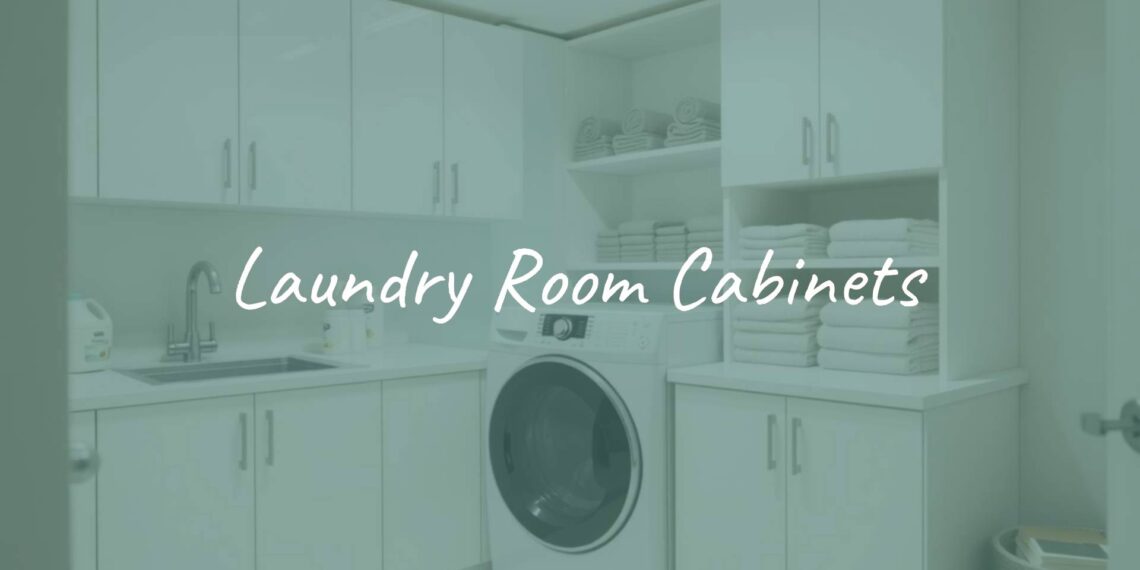Laundry room cabinets are storage units made to help you keep your laundry area neat, organized, and looking nice. These cabinets do a lot more than just hold stuff-they turn messy or ignored wash spaces into areas that are tidy, efficient, and even attractive. Cabinets give you dedicated space to store everything from detergent and dryer sheets to irons and folded clothes, making laundry day smoother and less stressful.
In many homes, the laundry room does a lot of work but often lacks proper storage and lighting or is squeezed into a small corner. Laundry room cabinets help solve these problems by giving you smart storage solutions. Whether you have just a little closet, a whole room, or use part of the garage or mudroom, the right cabinets can make a big difference. They cut down on mess, make chores easier, and let you manage laundry better-even when there’s a lot to do. In the end, laundry room cabinets are about making your laundry area work better and feel more inviting.

Why Use Laundry Room Cabinets?
Adding good cabinets to your laundry space has many benefits beyond just having a spot to store things. They make your laundry area easier to use and help everything run more smoothly, from making laundry faster to giving the room a more polished look.
Better Storage and Organization
With laundry room cabinets, you immediately get more storage and better organization. Instead of detergent, cleaning supplies, and stray socks taking over every surface, cabinets keep everything in its place. For example, you can keep all laundry items on one shelf and household cleaners on another. With tall cabinets, you can even use wall space that might otherwise go unused. Hiding items behind doors also keeps the space tidy.

Hide Appliances and Clear Out Clutter
Modern laundry rooms often hide washing machines and dryers with cabinet doors, so they blend in with the rest of the room. This is great in spaces like mudrooms or kitchens that double as laundry areas. Cabinets also keep dirty laundry or ironing boards out of sight with pull-outs or built-ins. Even a simple countertop on top of your machines can be a handy space for folding laundry.
Make Laundry Rooms Look Better
Today’s laundry rooms can be as stylish as any other room. Cabinets make the space feel up to date and match the rest of your house. For instance, you can choose neutral paint colors or matching cabinet pulls for a seamless look. White cabinets make the area look clean, while two-tone designs or interesting handles add personality.
Add Useful Features with Custom Cabinets
Custom laundry room cabinets can help your specific needs. Features like fold-down drying racks, pull-out hampers, or special shelves make laundry day much easier. Hooks and pull-out shelves help organize cleaning tools. Mesh shelves or racks can be built in for drying sweaters and delicate items. All of these choices help make your laundry process faster and more efficient.
Types of Laundry Room Cabinets
There are several styles of laundry cabinets, and each serves a different purpose. Choosing the right kind will help you get the best use out of your space.
Wall-Mounted Cabinets
Wall cabinets go above the washer, dryer, or countertop, using the space off the ground. They are great for keeping daily supplies close by, and because they are up high, you can add a hanging rod below for drying clothes. Some have doors that flip up-helpful if there’s not much room to swing a door out. Use these for items you don’t need every day.
Base Cabinets
Base cabinets sit on the floor and usually hold a countertop where you can sort or fold clothes. They’re good for hiding bigger items, storing hampers, or holding a wash sink. In narrow rooms, open base cabinets with baskets look good and are useful. Combining base and wall cabinets gives you a complete storage setup.
Tall and Utility Cabinets
Tall cabinets go from floor to ceiling and are good for storing bigger or less-used items, like brooms, mops, or even a steamer. In small rooms, a slim tall cabinet can use up a narrow space. For busy families, a whole wall of tall cabinets can give you plenty of room without taking up more floor.

Open Shelves vs. Closed Cabinets
Choosing between open shelves and closed cabinets changes how things look and work. Closed cabinets hide mess and look neat. Open shelves are easy to reach and can display baskets, towels, or little plants. Many people mix both-using closed cabinets for hidden storage and open shelves for things used often or for decoration.
Pantry-Style Cabinets
Large, tall pantry cabinets work well in laundry rooms. They can have adjustable shelves and special drawers. Use these to store big containers of detergent, extra towels, or bins with supplies. You can label or organize bins by task, making it easier to find what you need.
| Cabinet Type | Main Use | Typical Location |
|---|---|---|
| Wall-Mounted | Everyday supplies | Above washer, dryer, counters |
| Base | Larger items, hampers, workspace | Under counter, floor level |
| Tall/Utility | Brooms, mops, bulk items | Corner or full wall |
| Open Shelves | Easy-access, decoration | Anywhere, often mixed with others |
| Pantry-Style | Organized supplies, bulk storage | Full height, usually a wall end |
How to Pick Laundry Room Cabinets
Picking cabinets is more than just choosing a color. You’ll want to think about what they’re made of, the finish, hardware, and how they’ll handle laundry room conditions.
Materials: Wood, MDF, Metal, Laminate
- Wood: Classic and strong, but can swell or warp with moisture.
- MDF: Engineered wood that’s stable and budget-friendly. Needs good sealing in damp rooms.
- Metal: Tough and moisture-resistant, but looks industrial, which may not suit all styles.
- Laminate: Often used for its many color and pattern options. Easy to clean and doesn’t get damaged easily by water.

Finishes and Colors
White is timeless, but laundry rooms can be a place to try bold colors or patterns. Stained wood adds warmth, while glossy laminates are easy to wipe. Match finishes with the lighting, floor, and wall colors for a better look. Some people even match cabinet paint to their washer and dryer for a coordinated effect.
Hardware and Door Styles
Handles and knobs bring out the cabinet style-choose fun shapes or keep it simple for a modern feel. Shaker doors with simple frames are classic, while flat doors are sleek and modern. Glass doors keep things bright and let you show off organized shelves.
How Cabinets Handle Moisture
Laundry rooms get damp. Laminate and metal are a good choice because they won’t warp. If you use wood or MDF, seal them well. Make sure cabinets are well built and hardware is sturdy. Good air flow in the room helps protect cabinets in the long run.
Design Ideas for Laundry Room Cabinets
Cabinets can turn your laundry room into a space that’s both pretty and practical.
Fitting Cabinets in Small Spaces
Most laundry rooms are small. Use tall, skinny cabinets or floating shelves to make use of every bit of wall, and put cabinets above machines or sinks. Slim units can go between appliances or in unused corners. Even inside wall studs, you can put a fold-out ironing board or storage shelf.
Wall-to-Wall Storage
If you have space, a whole wall of cabinets will give you lots of storage and a finished look. A long countertop over machines gives plenty of room to fold. Mix closed cabinets and open shelves for both hidden and easy-to-grab storage.
Open Shelves with Cabinets
Open shelves give easy access to daily items and lighten the look of a cabinet wall. Use them for clean towels, decorative jars, or houseplants. Mix shelves with closed cabinets for balanced organization and display.
Two-Tone and Color Block Styles
To add life to your laundry room, try cabinets with two colors-for example, white uppers with blue or gray lowers. This helps define the space and adds a modern touch. Playing with color is a simple way to make your laundry room more fun.
Decorative Touches and Glass Doors
Add crown molding, special handles, or glass fronts for extra style. Glass doors open up the space. For something different, try chalkboard panels or unique handles. These touches let your laundry area look just as nice as the rest of your home.
Workstations with Cabinets
Good cabinets can be built around workspaces-a folding counter, built-in drying racks, or hidden ironing boards. A sink set into a cabinet gives you a spot for hand washing and soaking stains. Design your cabinets to match how you use the room.

Pet-Friendly Cabinet Ideas
If you have pets, you can add a pet bed nook to the lower cabinets or use cabinets to stash pet food and supplies. Built-in shelves below machines can hold pet baskets or create feeding stations. Planning for pets makes your laundry room even more useful.
Popular Laundry Cabinet Features and Extras
Modern laundry room cabinets come with many helpful features to keep the room tidy and easy to use.
- Built-in Drying Racks and Folding Areas: Pull-down or slide-out racks save space, while counter areas over the machines are perfect for folding.
- Pull-Out Hampers and Trays: Hide laundry or supplies in cabinet pull-outs, making sorting easy and the room less messy.
- Ironing Board Storage: Build ironing boards into a drawer or a slim cabinet-these fold away when not needed.
- Hooks, Baskets, Sliding Shelves: Use utility hooks for brooms, baskets for supplies, and sliding trays to make everything within reach.
Laundry Cabinets for Small Spaces
Even very small laundry rooms can work well with smart storage choices. Focus on using the wall and fitting cabinets to your needs.
Stackable and Modular Designs
For spaces with stacked washers and dryers, stackable cabinets fit right over or next to machines. Modular units can be arranged to fit awkward spaces and are easy to update later.
Under Sink and Overhead Solutions
An under-sink cabinet hides cleaning supplies and makes use of otherwise wasted space. Above your appliances, wall cabinets keep detergent and dryer sheets out of sight but easy to grab. In the tightest spaces, just a simple panel for folding or a single shelf above the machines can help.
Slim Cabinets for Narrow Spaces
For closets or tight corners, slim cabinets can fit where regular ones can’t. Use them for brooms, a fold-out ironing board, or tall bottles. Even in a closet, adding a counter and some wall cabinets turns the area into a hardworking laundry nook.
Should You Buy, Customize, or Build Cabinets Yourself?
Choosing your cabinets comes down to price, how unique you want your cabinets to be, and whether you prefer to hire a pro or do it yourself.
Cost: Store-Bought vs. Custom
- Store-bought cabinets (like those from Home Depot or IKEA) are the least expensive and easy to get. For example, some IKEA laundry cabinets cost around $30 to $170. These work well in standard spaces but offer fewer choices.
- Custom cabinets fit your exact space and needs. They look great and make the most of awkward floor plans, but are more expensive. Custom options can add lasting value to your home.
DIY Installation
- Building or installing cabinets yourself saves money if you can handle carpentry and measuring. Many big-box store cabinets have simple instructions, but you’ll need to make sure they’re level and secure.
- In laundry rooms, you might need help with plumbing or electrical work. Mistakes can be tricky to fix, so only DIY if you feel confident.
Hiring a Professional Designer
- Cabinet experts can design a laundry room that works for you, with all the right features and style. They’ll help avoid mistakes and deal with layout problems.
- Hiring a professional costs more but can be worth it for complex rooms or when you want a polished finish that saves time and effort.
Common Questions About Laundry Room Cabinets
What Are the Typical Sizes for Laundry Cabinets?
- Wall cabinets are usually 12-15 inches deep and 30-42 inches tall, but can be taller if running floor-to-ceiling.
- Base cabinets are about 24 inches deep and 34-36 inches high with countertops.
- Tall cabinets can be 18-30 inches deep and as much as 96 inches high.
- Store brands like IKEA offer specific sizes, such as 15 3/4″ x 74 3/4″ or 25 5/8″ x 74 3/4″.
How Do You Clean Laundry Room Cabinets?
- For laminate, painted, or melamine cabinets, use a damp cloth with mild soap. Avoid harsh cleaners.
- For wood, use cleaners made for wood and wipe dry after cleaning.
- Keep room well ventilated to fight moisture. Wipe up water or detergent spills fast. Organize inside the cabinets with bins to catch leaks, and check hardware now and then to keep things working smoothly.
Can I Re-Use Old Cabinets in the Laundry Room?
- You can reuse older kitchen or bathroom cabinets by painting them, changing hardware, or adding shelves and pull-outs for laundry use.
- You may need to remove doors to save space, or add a new countertop for a folding area. Make sure cabinets are solid and can handle the dampness of a laundry room.
















![What to with Scrap Metal? [infographic]?](https://facts-homes.com/wp-content/uploads/2019/07/645413-POPYOV-391-120x86.jpg)





